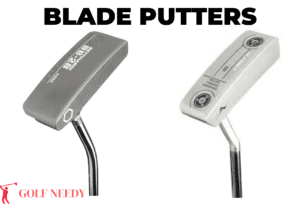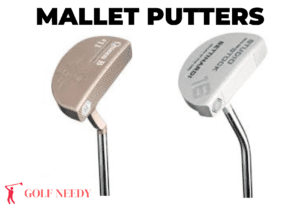Putter in Golfling to decide between a mallet or blade putter for your next golf game? Choosing the right putter can greatly impact your game, and with so many options available, it can be overwhelming to know where to start. In this comprehensive guide, we will explore the differences between mallet and blade putters, their advantages and disadvantages, and provide you with the information you need to choose the right putter for your playing style. So, what golf putter should you choose – mallet or blade, and why? Let’s find out.
To become a successful golfer, choosing the right putter is as important as any other golf equipment. In this article, we will explore the differences between mallet and blade putters, and help you pick the right one to improve your game.
Mallet and Blade Putters
Mallet putters are larger and have a more rounded clubhead than blade putters. They typically have a higher moment of inertia, which provides more forgiveness and stability. They also often feature alignment aids to help golfers line up their shots.
Blade putters, on the other hand, have smaller, flatter clubheads that are more traditional in shape. They tend to be lighter than mallet putters and are favored by golfers who prefer a more classic look and feel.
Importance of Choosing the Right Putter

Choosing the right putter is crucial to performing your best on the course. As the club you use the most throughout the round, a poorly fitting putter can significantly impact your performance. The right putter can help you make more accurate shots and sink more putts, leading to a better overall score. It is essential to choose a putter that fits your playing style and preferences, and we will guide you through the process to ensure you make an informed decision.
- Alignment and Confidence:A putter that is well-aligned with your stance, eye position, and stroke may improve your putting accuracy dramatically. The correct putter should instill confidence at the address, assuring you that your alignment is perfect. This alignment synergy between you and your putter can aid in the maintenance of a steady putting stroke, resulting in more precise putts.
- Feel and Balance: Every golfer has a distinct putting stroke and preferred putter feel. The ideal putter should be balanced to your stroke and deliver the necessary feedback. Finding the appropriate balance can help you attain a more natural and consistent feel on your putts, whether you like a toe-heavy putter for a modest arc or a face-balanced putter for a straight-back-straight-through stroke.
- Length and Fit: The length of your putter is another critical factor to consider. A putter that is too long or too short can adversely affect your posture, setup, and distance control. Finding the right length that allows you to maintain a comfortable and consistent setup position is essential for a smooth putting stroke. Additionally, the grip size and shape should also match your hand size and grip preference to promote a confident and comfortable feel during your stroke.
- Green Conditions and Stroke Type: The sort of greens you usually face, as well as your stroke style, might impact which putter you should choose. varied putters have varied face inserts and head designs, each with its own set of feedback and performance qualities. Milled face putters, for example, may suit individuals who like a stronger feel and increased feedback, whilst inserts made of softer materials may give a more forgiving and softer feel. Understanding your stroke style and the greens you play on might assist you in choosing a putter that will maximize your performance on those surfaces.
- Personal Preference and Aesthetics: Lastly, it’s crucial to consider personal preference and aesthetics when choosing a putter. Golf is a game of confidence, and if a putter appeals to your eye and instills a sense of joy and connection, it can positively influence your overall performance on the greens. Whether it’s the shape, color, or design, selecting a putter that resonates with you on a personal level can enhance your enjoyment and connection to the game.
The Impact of Putter Design on Golf Performance
Choosing the right putter can have a significant impact on your overall golf performance. The shape, weight, and balance of a putter can all affect your ability to make accurate putts and improve your score.
The Putter Shape
Mallet putters are known for their larger sweet spot and higher moment of inertia (MOI), making them more forgiving on off-center hits. This means that even if you don’t hit the ball perfectly in the center of the clubface, the putter is less likely to twist, and you still have a chance of making the putt. In contrast, blade putters have a smaller sweet spot and lower MOI, making them less forgiving on off-center hits. This means that you need to hit the ball closer to the center of the clubface to make an accurate putt.
The Putter Weight and Balance
Mallet putters are typically heavier than blade putters, which can help maintain a smooth, consistent stroke. They also tend to have a higher center of gravity, which can create a more consistent roll and reduce the chance of skidding or bouncing off the green. Blade putters, on the other hand, are typically lighter and have a lower center of gravity, which can allow for more feel and control in the stroke. This can be beneficial for golfers who have a consistent putting stroke and prefer a lighter, more responsive putter.
RELATED: What is a Putter in Golf and Why is it Important?
The Putter Alignment Aids
Mallet putters often feature alignment aids such as lines or dots on the clubhead to help golfers line up their shots more accurately. This can be beneficial for golfers who struggle with alignment or have a tendency to push or pull their putts. Blade putters, on the other hand, typically do not have alignment aids, which can make it more difficult to line up shots accurately. This can be challenging for golfers who struggle with alignment or consistency.
In summary, when choosing a putter, you should consider the shape, weight, and balance of the putter, as well as any alignment aids that may help improve your accuracy. By finding a putter that suits your playing style and preferences, you can improve your overall golf performance and lower your score.
Mallet vs Blade Putters: Key Differences


Choosing the right putter is essential for a good golf game. Two popular options are the mallet and blade putters, but what are the differences between them?
The Design and Construction of the Putter
Mallet putters are larger and more complex in design than blade putters. They feature a larger sweet spot and a higher moment of inertia (MOI), which means the club head is less likely to twist on off-center hits. Blade putters, on the other hand, are typically more simplistic in design and feature a smaller sweet spot and lower MOI.
The Size and Shape of the Putter
Mallet putters have a wider clubhead and a larger face, which can help golfers with alignment. They are generally more rounded in shape than blade putters. Blade putters, on the other hand, have a more traditional shape and are typically thinner and flatter than mallet putters.
The Weight and Balance of the Putter
Mallet putters are generally heavier than blade putters, which can help golfers maintain a smooth, consistent stroke. They also tend to have a higher center of gravity, which can help create a more consistent roll. Blade putters, on the other hand, are typically lighter and have a lower center of gravity, which can allow for more feel and control in the stroke.
Examples of Mallet and Blade Putters
Some popular mallet putters include the TaylorMade Spider X, the Odyssey Stroke Lab Seven, and the Ping Sigma 2 Tyne. Popular blade putters include the Scotty Cameron Newport 2, the TaylorMade TP Patina Soto, and the Ping Vault 2.0 Dale Anser.
How Design Affects Performance
The design of a putter can greatly impact its performance. Mallet putters are often favored by golfers who struggle with alignment or have a tendency to pull or push their putts. The larger size and alignment aids of mallet putters can help golfers line up their shots more accurately. Blade putters, on the other hand, are often favored by golfers who prefer a more traditional look and feel and who have a more consistent putting stroke.
Overall, the choice between a mallet and blade putter comes down to personal preference and playing style. It’s essential to try out both types of putters to determine which one feels most comfortable and helps you achieve the best results on the green.
Experts’ Tips for Choosing the Right Putter

Choosing the right putter can be a daunting task, but golf experts’ advice can make the process easier. Here are some tips from golf experts to help you choose the right putter:
Tip 1: Test Different Putters
According to John Smith, a golf coach, and instructor, finding a putter that feels comfortable and natural is vital. Therefore, try different putters and pay attention to their weight, balance, alignment aids, and how they respond to different strokes.
Tip 2: Consider Your Playing Style
Mike Johnson, a golf pro, suggests that one’s playing style could have a significant impact on the type of putter that works best. For example, if you have trouble with alignment or have a tendency to push or pull your putts, a mallet putter may be the right choice. On the other hand, if you have a consistent putting stroke and prefer a traditional look and feel, a blade putter may be the better option.
Tip 3: Look for Quality Construction
Lisa Rodriguez, a golf equipment expert, recommends choosing a putter that is well-made and has quality construction and materials. The putter should have a comfortable grip and a smooth, consistent stroke, which will result in more accurate putts and better golf performance.
Choosing the Right Putter: Considerations and Tips
Choosing the right putter is crucial to improving your game. Here are some factors to consider to ensure you find the best fit for your individual needs.
Playing Style and Preferences
Consider your playing style and preferences when choosing a putter. Golfers who prefer a more traditional look and feel may opt for a blade putter, while those who struggle with alignment may benefit from a mallet putter. It’s essential to find a putter that feels comfortable and natural in your hands.
Putter Design
The design of the putter is also essential in finding the right fit. The size and shape of the clubhead, weight, balance, and alignment aids all play a role in your performance. Golfers who prefer a larger sweet spot and more forgiveness on off-center hits may benefit from a mallet putter. On the other hand, those who value feel and control may prefer a blade putter.
Putter Testing
Testing different putters is crucial to finding the perfect fit. Take the time to try out different putters and pay attention to how they feel in your hands. Try different strokes and pay attention to how the putter responds to your movements. It’s also essential to test the putter on different greens to see how it performs in various conditions. Remember, finding the right putter isn’t a one-size-fits-all approach, so take your time and experiment with different options until you find the perfect fit.
RELATED: Golf Driver Buying Guide 2023
Best Mallet Putters: Top Picks for Stability and Forgiveness
If you’ve decided that a mallet putter is the right choice for you, then you’re in luck. There are several excellent options on the market that can help you improve your accuracy and stability on the green. Here are our top picks for the best mallet putters:
1. TaylorMade Spider X
The TaylorMade Spider X is a popular choice among golfers who want a high MOI putter with excellent alignment aids. The Spider X is designed with a new frame that allows for more weight to be positioned at the back of the putter, making it more forgiving and stable. The putter also features a True Path alignment system that helps golfers line up their putts more accurately.
2. Odyssey Stroke Lab Seven
The Odyssey Stroke Lab Seven is another mallet putter that boasts a unique weighting system and a high MOI. The putter features a multi-material Stroke Lab shaft that helps golfers achieve better tempo and stroke consistency. The Seven also has a Microhinge Star insert that provides excellent feel and sound.
3. Ping Sigma 2 Tyne
The Ping Sigma 2 Tyne is a mallet putter that provides a soft, responsive feel and an adjustable-length shaft. The putter features a multi-piece face that helps to deliver consistent ball speed and distance control. The Tyne also has a high MOI for increased stability and forgiveness on off-center strikes.
PRO TIP:
– When testing out mallet putters, pay attention to the weight and balance of each putter to find the one that feels most comfortable.
– Consider the alignment aids and face insert of each mallet putter to determine which one provides the best feel and accuracy.
– Don’t be afraid to experiment with different mallet putters until you find the one that works best for you.
Remember, the best mallet putter for you is ultimately the one that feels most comfortable and helps you achieve the best results on the green.
Best Blade Putters for Golfers Who Value Feel and Customization
If you’re a golfer who values feel and customization in their putter, a blade putter might be the perfect choice for you. Here are some of the best blade putters on the market that offer an excellent feel and customizable options to help you improve your game.
Scotty Cameron Newport 2
The Scotty Cameron Newport 2 is a classic blade putter that has been favored by professionals for years. This putter features a sleek design with a milled face that provides a soft feel and excellent feedback. The Newport 2 also offers customizable options such as adjustable weights and a variety of grip options.
TaylorMade TP Patina Soto
The TaylorMade TP Patina Soto is a beautifully designed blade putter that offers a clean, traditional look. Its soft feel and sound are thanks to the Pure Roll insert, which promotes forward spin and helps keep your putts on line. The TP Patina Soto also offers customizable options such as adjustable weights and lengths.
Ping Vault 2.0 Dale Anser
The Ping Vault 2.0 Dale Anser is a modern take on a classic design, offering golfers a high-quality finish and a comfortable grip. The milled face provides excellent feedback and a soft feel, while the adjustable weights allow you to customize the putter to your liking. The Ping Vault 2.0 Dale Anser is a great option for golfers who want a classic look with modern performance.
Using one of these blade putters can help you improve your putting game, especially if you value feel and customization. Take some time to test out these putters and see which one feels the most comfortable to you.
Difference Between Mallet Or Blade Putter?
| Mallet Putter | Blade Putter | |
|---|---|---|
| Design and Appearance | Larger, elongated head with deep, hollow cavity and alignment aids | Traditional, compact blade-like head with minimal or no alignment aids |
| Forgiveness and Stability | Higher forgiveness and stability on off-center hits due to increased MOI | Less forgiveness on off-center strikes with a smaller sweet spot |
| Weight Distribution and Feel | Weight concentrated towards the perimeter for a stable and balanced feel | Weight focused in the center for a responsive and precise feel |
| Alignment and Visual Aid | Prominent alignment aids on the back of the putter head | Simpler design without explicit alignment aids |
| Preference for Skilled Golfers | May prefer the stability and feedback of a mallet putter | May prefer the responsiveness and feel of a blade putter |
| Preference for Alignment Assistance | Can assist with alignment due to visual aids | Relies on natural alignment instincts without explicit aids |
Conclusion
In conclusion, selecting the right putter is a crucial step in improving your golf game. Choosing between a mallet or blade putter will depend on your personal preferences and playing style. However, it’s essential to consider factors such as clubhead size and shape, weight and balance, and alignment aids to find the putter that feels the most comfortable and natural in your hands.
Investing in the right putter can lead to improved accuracy and better overall scores. By practicing regularly with your chosen putter and focusing on your technique, you can take your putting game to the next level.
So, whether you prefer the stability of a mallet putter or the feel of a blade putter, take the time to test out different options and find the right fit. With the right putter in hand, you’ll be well on your way to becoming a successful golfer.
RELATED: Why Are Golf Carts So Expensive?
FAQ
Q: Who should choose a mallet putter?
A: Golfers who struggle with alignment or off-center hits.
Q: What is the difference between a mallet and a blade putter?
A: Mallets have a larger clubhead and are more forgiving, while blades are more traditional in shape.
Q: How do I know which putter is right for me?
A: Consider your playing style, and preferences, and test different putters.
Q: Who should choose a blade putter?
A: Golfers who have a consistent putting stroke and prefer a traditional look and feel.
Q: What should I consider when choosing a putter?
A: Putter design, weight, balance, and alignment aids.
Q: How can choosing the right putter impact my game?
A: It can lead to more accurate putts and better overall scores.

I’m Donna Weiss, and I am the proud writer behind the captivating content you’ll find on golfneedy.com. As an avid golfer and passionate writer, I have combined my two greatest passions to bring you an incredible golfing experience. Through my articles, I aim to provide you with valuable insights, equipment reviews, and updates on the latest tournaments. Whether you’re a seasoned golfer or just starting out on this exciting journey, I am here to guide you and share my expertise. Together, let’s explore the fascinating world of golf, uncovering new techniques, and enhancing our skills. Join me on this thrilling adventure as we elevate our game and embark on an exciting golfing journey. Read More



